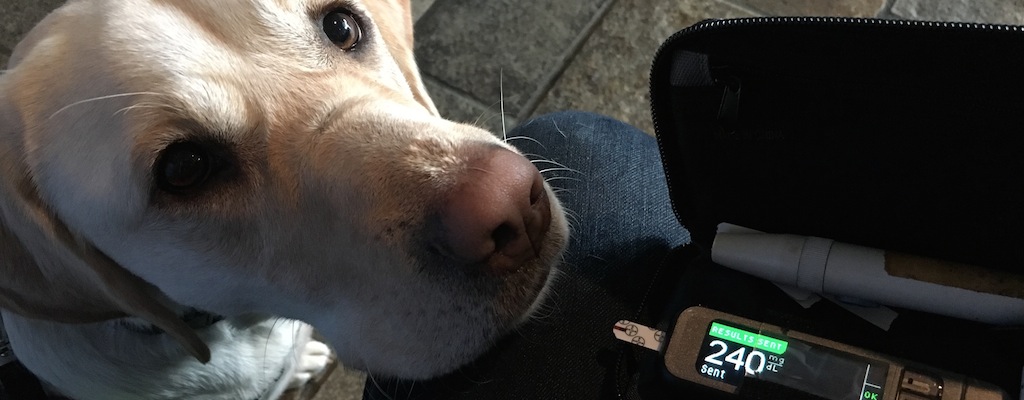Diabetic Alert Dogs (DADs)
What are Diabetic Alert Dogs (DADs)?
Diabetic alert dogs—affectionately known as DADs—are service dogs that are trained specifically to assist people with diabetes.
Their primary task as service dogs is to alert people with diabetes of an oncoming hypoglycemic or hyperglycemic event (low or high blood sugar!)
DADs are able to do this by reacting to particular smells that are emitted from the human body due to chemical shifts caused by either hypoglycemia or hyperglycemia (undetected by a human nose).
There are various ways that the dog can alert their human of a low or high blood sugar, which all depends on how it is trained. These skills require rigorous training from professional service dog trainers.
In addition to being on alert for blood sugar malfunctions, Diabetic alert dogs are known to provide a tremendous amount of love and emotional support to its owner, resulting in an increased sense of security and balance in the daily life of someone with type 1.
How can I find my own DAD?
Getting a diabetic alert dog of your very own is a process. The first step is to find a legitimate, accredited organization made up of trainers that will assist you in both the acquiring and the training of your new DAD. Alternatively, there are diabetic alert dog training schools that will assist in the training and development of the dog of your own choosing. After being matched with the right dog for you, you may be asked to provide a “scent collection kit” so that your dog can learn your body chemistry during its training. Home visits are scheduled in order to begin the bonding process.
Organizations & Resources
How long do I have to wait for my dog?
The average wait time for your DAD to be ready to come home with you for good is approximately six months to a year.
What is the cost?
The exact cost will depend on the particular organization and training program selected. But on average—an investment in a diabetic alert dog can cost anywhere from $8,000 to $20,000. There are non-profits that grant dogs for free and only require that you pay for your training with the dog. Dogs 4 Diabetics out of Concord, California, provides diabetic alert dogs and training for free if you qualify.
Read Dog Talk with Early Alert Canines to learn more on average training fees.
About service dogs
There are many kinds of service dogs that fall into the medical alert dog category, each are trained to assist humans with their unique disabilities.
- Guide Dogs (for the blind)
- Hearing Dogs
- Psychiatric Service Dogs
- Mobility Assistance Dogs
Under the Americans with Disabilities Act, every trained and accredited service dog wearing a service vest is allowed to accompany their owner to any privately owned business that serves the public—restaurants, hotels, movie theaters, retail shops, sports venues and more. Service dogs may also join their humans on airplanes for no additional fee. A service animal is not considered just a “pet.”
A brief history
The use of service dogs first came about in 1863, in the form of the American Civil War Therapy Dogs. A training school for Law Enforcement Dogs was established in 1899, and in 1929, the world met its first seeing eye dogs.
A woman named Dorothy Harrison Eustis ran a training program in Switzerland for guide dogs in the 1920s, and trained the United States’ first known seeing eye dog named “Kiss.”
Before they were established in the US, guide dog training programs were established in both Switzerland and Germany.
Today, as we can see—service dogs are utilized in so many different ways, and have remained loyal servants and best of friends to those who need them the most.
Read a personal account: Elle and Coach — How a Diabetes Alert Dog Changed My Daughter’s Life by Stefany Shaheen.
Read My Best Friend Addie, The Alert Dog by Russell Roberts.
Read Maggie Jones’ advice: Consider This Before Getting a Diabetic Alert Dog





